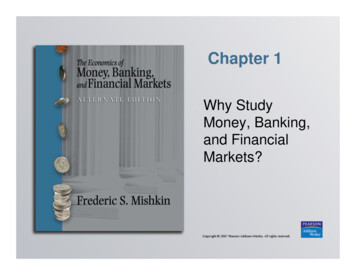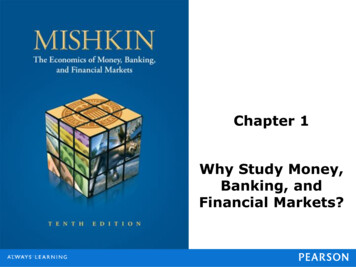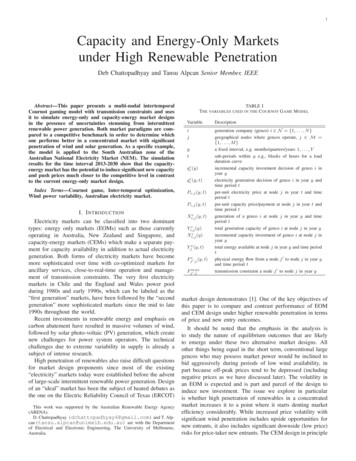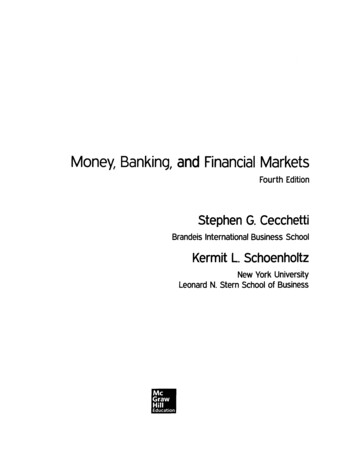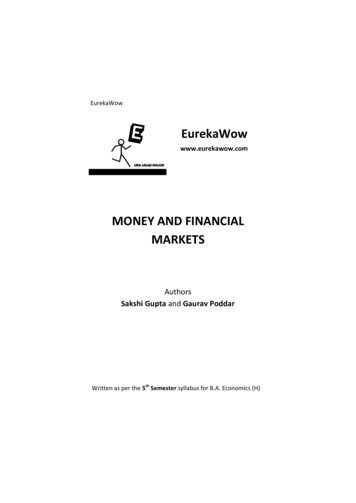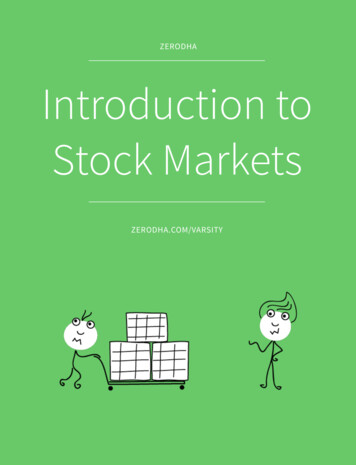
Transcription
Guide to Financial MarketsGuide to Financial Markets.indd 123/10/2013 14:14
other economist booksGuide to Analysing CompaniesGuide to Business ModellingGuide to Business PlanningGuide to Cash ManagementGuide to CommoditiesGuide to Decision MakingGuide to Economic IndicatorsGuide to Emerging MarketsGuide to the European UnionGuide to Financial ManagementGuide to Hedge FundsGuide to Investment StrategyGuide to Management Ideas and GurusGuide to Managing GrowthGuide to Organisation DesignGuide to Project ManagementGuide to Supply Chain ManagementNumbers GuideStyle GuideBook of Business QuotationsBook of IsmsBook of ObituariesBrands and BrandingBusiness ConsultingBusiness StrategyBuying Professional ServicesDoing Business in ChinaEconomicsManaging TalentManaging UncertaintyMarketingMarketing for GrowthMegachange – the world in 2050Modern Warfare, Intelligence and DeterrenceOrganisation CultureSuccessful Strategy ExecutionThe World of BusinessDirectors: an A–Z GuideEconomics: an A–Z GuideInvestment: an A–Z GuideNegotiation: an A–Z GuidePocket World in FiguresGuide to Financial Markets.indd 229/10/2013 14:40
Guide to FinancialMarketsWhy they exist and how they workSixth editionMarc LevinsonGuide to Financial Markets.indd 329/10/2013 16:52
THE ECONOMIST IN ASSOCIATION WITHPROFILE BOOKS LTDPublished by Profile Books Ltd3a Exmouth HousePine StreetLondon ec1r 0jhwww.profilebooks.comCopyright The Economist Newspaper Ltd, 1999, 2000, 2002, 2006, 2010, 2014Text copyright Marc Levinson, 2014All rights reserved. Without limiting the rights under copyright reserved above, no partof this publication may be reproduced, stored in or introduced into a retrieval system,or transmitted, in any form or by any means (electronic, mechanical, photocopying,recording or otherwise), without the prior written permission of both the copyrightowner and the publisher of this book.The greatest care has been taken in compiling this book. However, no responsibilitycan be accepted by the publishers or compilers for the accuracy of the informationpresented.Where opinion is expressed it is that of the author and does not necessarily coincidewith the editorial views of The Economist Newspaper.While every effort has been made to contact copyright-holders of material produced orcited in this book, in the case of those it has not been possible to contact successfully,the author and publishers will be glad to make amendments in further editions.Typeset in EcoType by MacGuru Ltdinfo@macguru.org.ukPrinted in Great Britain by Clays, Bungay, SuffolkA CIP catalogue record for this book is available from the British LibraryHardback isbn: 978 1 78125 106 5Paperback isbn: 978 1 78125 107 2e-book isbn: 978 1 84765 953 8The paper this book is printed on is certified by the 1996 Forest Stewardship Council A.C. (FSC).It is ancient-forest friendly. The printer holds FSC chain of custody SGS-COC-2061Guide to Financial Markets.indd 429/10/2013 14:43
Contents123456789Why markets matter Foreign-exchange markets Money markets Bond markets Securitisation International fixed-income markets Equity markets Futures and options markets Derivatives markets 1174470111137154197253Index 275Guide to Financial Markets.indd 523/10/2013 14:14
Guide to Financial Markets.indd 623/10/2013 14:14
1Why markets matterThe euro is slightly higher against the yen. The Dow JonesIndustrial Average is off 18 points in active trading. A Chinese airlineloses millions of dollars with derivatives. Following the Bank ofEngland’s decision to lower its base rate, monthly mortgage paymentsare set to fall.All these events are examples of financial markets at work. Thatmarkets exercise enormous influence over modern life comes as nonews. But although people around the world speak glibly of “WallStreet”, “the bond market” and “the currency markets”, the meaningsthey attach to these time-worn phrases are often vague and usually outof date. This book explains the purposes different financial marketsserve and clarifies the way they work. It cannot tell you whether yourinvestment portfolio is likely to rise or to fall in value. But it may helpyou understand how its value is determined, and how the differentsecurities in it are created and traded.In the beginningThe word “market” usually conjures up an image of the bustling,paper-strewn floor of the New York Stock Exchange or of tradersmotioning frantically in the futures pits of Chicago. These imagesthemselves are out of date, as almost all of the dealing once done faceto face is now handled computer to computer, often with minimalhuman intervention. And formal exchanges such as these are onlyone aspect of the financial markets, and far from the most importantone. There were financial markets long before there were exchangesand, in fact, long before there was organised trading of any sort.Guide to Financial Markets.indd 123/10/2013 14:14
2Guide to financial marketsFinancial markets have been around ever since mankind settleddown to growing crops and trading them with others. After a badharvest, those early farmers would have needed to obtain seed for thenext season’s planting, and perhaps to get food to see their familiesthrough. Both of these transactions would have required them toobtain credit from others with seed or food to spare. After a goodharvest, the farmers would have had to decide whether to trade awaytheir surplus immediately or to store it, a choice that any 21st-centurycommodities trader would find familiar. The amount of fish thoseearly farmers could obtain for a basket of cassava would have variedday by day, depending upon the catch, the harvest and the weather;in short, their exchange rates were volatile.The independent decisions of all of those farmers constituted abasic financial market, and that market fulfilled many of the samepurposes as financial markets do today.What do markets do?Financial markets take many different forms and operate in diverseways. But all of them, whether highly organised, like the LondonStock Exchange, or highly informal, like the money changers on thestreet corners of some African cities, serve the same basic functions. Price setting. The value of an ounce of gold or a share of stockis no more, and no less, than what someone is willing to pay toown it. Markets provide price discovery, a way to determine therelative values of different items, based upon the prices at whichindividuals are willing to buy and sell them. Asset valuation. Market prices offer the best way to determinethe value of a firm or of the firm’s assets, or property. This isimportant not only to those buying and selling businesses, butalso to regulators. An insurer, for example, may appear strong ifit values the securities it owns at the prices it paid for them yearsago, but the relevant question for judging its solvency is whatprices those securities could be sold for if it needed cash to payclaims today.Guide to Financial Markets.indd 223/10/2013 14:14
Why markets matter Arbitrage. In countries with poorly developed financial markets,commodities and currencies may trade at very different pricesin different locations. As traders in financial markets attempt toprofit from these divergences, prices move towards a uniformlevel, making the entire economy more efficient. Raising capital. Firms often require funds to build new facilities,replace machinery or expand their business in other ways.Shares, bonds and other types of financial instruments make thispossible. The financial markets are also an important source ofcapital for individuals who wish to buy homes or cars, or evento make credit-card purchases. Commercial transactions. As well as long-term capital,the financial markets provide the grease that makes manycommercial transactions possible. This includes such thingsas arranging payment for the sale of a product abroad, andproviding working capital so that a firm can pay employees ifpayments from customers run late. Investing. The stock, bond and money markets provide anopportunity to earn a return on funds that are not neededimmediately, and to accumulate assets that will provide anincome in future. Risk management. Futures, options and other derivativescontracts can provide protection against many types of risk, suchas the possibility that a foreign currency will lose value againstthe domestic currency before an export payment is received.They also enable the markets to attach a price to risk, allowingfirms and individuals to trade risks so they can reduce theirexposure to some while retaining exposure to others.3The size of the marketsEstimating the overall size of the financial markets is difficult. It ishard in the first place to decide exactly what transactions should beincluded under the rubric “financial markets”, and there is no way tocompile complete data on each of the millions of sales and purchasesoccurring each year. Total capital market financing was approximatelyGuide to Financial Markets.indd 323/10/2013 14:14
4Guide to financial markets 6.5 trillion worldwide in 2011, excluding purely domestic loans thatwere not resold in the form of securities (see Table 1.1).Table 1.1 Amounts raised in financial marketsNet of repayments, bnInternational bank loansInternational bonds and notesInternational money-market instruments20002004200620087141,3432,816 ��6Domestic bonds and notes8652,4612,3222,2822,566Domestic money-market instruments3777749831,462–611International equity issues318214371392485Domestic equity issuesTotal excluding domestic es: Bank for International Settlements; World Federation of Exchanges; Thomson ReutersThe figure of 4.5 trillion for 2011, sizeable as it is, represents only asingle year’s activity. Another way to look at the markets is to estimatethe value of all the financial instruments they trade. When measuredin this way, the financial markets accounted for 180 trillion of capitalin 2011 (see Table 1.2). This figure excludes many important financialactivities, such as insurance underwriting, bank lending to individualsand small businesses, and trading in financial instruments such asfutures and derivatives that are not means of raising capital. If all ofthese other financial activities were to be included, the total size ofthe markets would be much larger.Cross-border measureAnother way of measuring the growth of finance is to examine thevalue of cross-border financing. Cross-border finance is by no meansnew, and at various times in the past (in the late 19th century, forexample) it has been quite large relative to the size of the worldeconomy. The period since 1990 has been marked by a huge increaseGuide to Financial Markets.indd 423/10/2013 14:14
Why markets matter 5Table 1.2 The world’s financial marketsYear end, trnInternational bonds and notesInternational money-market instrumentsDomestic bonds and 0.91.11.023.835.949.759.769.6Domestic money-market instruments6.08.210.112.811.5International bank .4Total value outstanding75.6109.1148.7152.6180.3Sources: Bank for International Settlements; World Federation of Exchangesin the amount of international financing broken by financial crisesin Asia and Russia in 1998, the recession in the United States in 2001,and the financial meltdowns of 2008–09 in the United States and2008–13 in Europe. The total stock of cross-border finance in 2013,including international bank loans and debt issues, was more than 52 trillion, according to the Bank for International Settlements.Looking strictly at securities provides an even more dramaticpicture of the growth of the financial markets. A quarter of a centuryago, cross-border purchases and sales of securities amounted to onlya tiny fraction of most countries’ economic output. Today, annualcross-border share and bond transactions are several times larger thanGDP in a number of advanced economies – Japan being a notableexception.International breakdownThe ways in which firms and governments raise funds in internationalmarkets have changed substantially. In 1993, bonds accounted for59% of international financing. By 1997, before the financial crises inAsia and Russia shook the markets, only 47% of the funds raised oninternational markets were obtained through bond issues. Equitiesbecame an important source of cross-border financing in 2000, whenshare prices were high, but bonds and loans regained importanceGuide to Financial Markets.indd 523/10/2013 14:14
6Guide to financial marketsin the low-interest-rate environment of 2002–05. In 2008, syndicatedlending fell off as lack of capital forced banks to restrain their lendingactivities. Issuance of international bonds was relatively flat in theyears following 2008, as non-financial companies increased theirbond issuance even while banks reduced their outstanding bondindebtedness. Table 1.3 lists the amounts of capital raised by the maininstruments used in international markets.Table 1.3 Financing on international capital marketsType of instrument, bnBonds and money-market 705317214392630Syndicated Source: Bank for International SettlementsTurn-of-the-century slowdownBy all these measures, financial markets grew rapidly during the 1990s.At the start of the decade, active trading in financial instruments wasconfined to a small number of countries, and involved mainly thesame types of securities, bonds and equities that had dominatedtrading for two centuries. By the first years of the 21st century, financialmarkets were thriving in dozens of countries, and new instrumentsaccounted for a large proportion of market dealings.The expansion of financial-market activity paused in 1998in response to banking and exchange-rate crises in a number ofcountries. The crises passed quickly, however, and in 1999 financialmarket activity reached record levels following the inauguration of thesingle European currency, interest-rate decreases in Canada, the UKand Continental Europe, and a generally positive economic picture,marred by only small rises in interest rates, in the United States.Equity-market activity slowed sharply in 2000 and 2001, as shareprices fell in many countries, but bond-market activity was robust.Guide to Financial Markets.indd 623/10/2013 14:14
Why markets matter 7Trading in foreign-exchange markets fell markedly at the turn of thecentury. Credit and equity markets around the world were buoyantin 2006–07, but then contracted abruptly as financial crisis led tothe failures of several major financial institutions and a dramaticreduction in lending. Although credit markets began to recoverin 2009, their expansion was subdued because of the prolongedfinancial crisis affecting the euro zone, recession or sluggish growth ina number of major economies, and new regulatory requirements thatconstrained bank lending and discouraged use of certain financingmethods, notably securitisation. By making large-scale purchases ofbonds in 2010–13, the major central banks played a significant role insupporting credit-market expansion to meet the needs of businessesand households.The long-run trends of increased financial-market activity can betraced to four main factors: Lower inflation. Inflation rates around the world have fallenmarkedly since the 1980s. Inflation erodes the value of financialassets and increases the value of physical assets, such as housesand machines, which will cost far more to replace than theyare worth today. When inflation is high, as was the case in theUnited States, Canada and much of Europe during the 1970sand throughout Latin America in the 1980s, firms avoid raisinglong-term capital because investors require a high return oninvestment, knowing that price increases will render much ofthat return illusory. In a low-inflation environment, however,financial-market investors require less of an inflation premium,as they do not expect general increases in prices to devalue theirassets. Pensions. A significant change in pension policies occurredin many countries starting in the 1990s. Since the 1930s, andeven earlier in some countries, governments have operatedpay-as-you-go schemes to provide income to the elderly. Theseschemes, such as the old age pension in the UK and the socialsecurity programme in the United States, tax current workersto pay current pensioners and therefore involve no saving orinvestment. Changes in demography and working patterns haveGuide to Financial Markets.indd 723/10/2013 14:14
8Guide to financial marketsmade pay-as-you-go schemes increasingly costly to support,as there are fewer young workers relative to the number ofpensioners. This has stimulated interest in pre-funded individualpensions, whereby each worker has an account in which moneymust be saved, and therefore invested, until retirement. Althoughthese personal investment accounts have to some extentsupplanted firms’ private pension plans, they have also led toa huge increase in financial assets in countries where privatepension schemes were previously uncommon. Stock and bond market performance. Many countries’ stockand bond markets performed well during most of the 1990s andin the period before 2008, with the global bond-market boomcontinuing until interest rates began to rise in 2013. Stockmarkets,after several difficult years, rose steeply in many countries in2012 and 2013. A rapid increase in financial wealth feeds onitself: investors whose portfolios have appreciated are willing toreinvest some of their profits in the financial markets. And theappreciation in the value of their financial assets gives investorsthe collateral to borrow additional money, which can then beinvested. Risk management. Innovation has generated many newfinancial products, such as derivatives and asset-backedsecurities, whose basic purpose is to redistribute risk. This ledto enormous growth in the use of financial markets for riskmanagement purposes. To an extent previously unimaginable,firms and investors could choose which risks they wished tobear and use financial instruments to shed the risks they didnot want, or, alternatively, to take on additional risks in theexpectation of earning higher returns. The risk that the eurowill trade above 1.40 during the next six months, or that theinterest rate on long-term US Treasury bonds will rise to 6%, isnow priced precisely in the markets, and financial instruments toprotect against these contingencies are readily available. The riskmanagement revolution thus resulted in an enormous expansionof financial-market activity. The credit crisis that began in2007, however, revealed that the pricing of many of these riskmanagement products did not properly reflect the risks involved.Guide to Financial Markets.indd 823/10/2013 14:14
Why markets matter 9As a result, these products have become more costly, and arebeing used more sparingly, than in earlier years.The investorsThe driving force behind financial markets is the desire of investors toearn a return on their assets. This return has two distinct components: Yield is the income the investor receives while owning aninvestment. Capital gains are increases in the value of the investment itself,and are often not available to the owner until the investment issold.Investors’ preferences vary as to which type of return they prefer,and these preferences, in turn, will affect their investment decisions.Some financial-market products are deliberately designed to offer onlycapital gains and no yield, or vice versa, to satisfy these preferences.Investors can be divided broadly into two categories: Individuals. Collectively, individuals own a small proportionof financial assets. Most households in the wealthier countriesown some financial assets, often in the form of retirementsavings or of shares in the employer of a household member.Most such holdings, however, are quite small, and theircomposition varies greatly from one country to another.In 2010, equities accounted for 9% of households’ financialassets in Germany but 34% in Finland. The great majority ofindividual investment is controlled by a comparatively smallnumber of wealthy households. Nonetheless, individualinvesting has become increasingly popular. In the United States,bank certificates of deposit accounted for more than 10% ofhouseholds’ financial assets in 1989 but only 3.9% in 2010, asfamilies shifted their money into securities held in retirementaccounts. The 2008–09 stockmarket crash caused householdsto hold a smaller proportion of their assets in equities, but theextremely low interest rates available on bond investments andGuide to Financial Markets.indd 923/10/2013 14:14
10Guide to financial marketsbank deposits drove individual investors back towards equitiesin 2013. Institutional investors. Insurance companies and otherinstitutional investors (see below), including high-frequencytraders, are responsible for most of the trading in financialmarkets. The assets of institutional investors based in the 34member countries of the OECD totalled more than 62 trillionin 2011. The size of institutional investors varies greatly fromcountry to country, depending on the development of collectiveinvestment vehicles. Investment practices vary considerablyas well. At the end of 2011, after a significant decrease in shareprices, for example, US institutional investors kept roughlyidentical proportions of their assets in the form of shares andin bonds. Until recently, British institutional investors tendedto hold a greater proportion of assets in shares, whereasinstitutional investors in Japan have tended to favour bonds andloans over shares.Mutual fundsThe fastest-growing institutional investors are investment companies,which combine the investments of a number of individuals with theaim of achieving particular financial goals in an efficient way. Mutualfunds and unit trusts are investment companies that typically acceptan unlimited number of individual investments. The fund declares thestrategy it will pursue, and as additional money is invested the fundmanagers purchase financial instruments appropriate to that strategy.Investment trusts, some of which are known in the United States asclosed-end funds, issue a limited number of shares to investors at thetime they are established and use the proceeds to purchase financialinstruments in accordance with their strategy. In some cases, the trustacquires securities at its inception and never sells them; in other cases,the fund changes its portfolio from time to time. Investors wishing toenter or leave the unit trust must buy or sell the trust’s shares fromstockbrokers. Worldwide, mutual funds had net assets of 27 trillionat the end of 2012.Guide to Financial Markets.indd 1023/10/2013 14:14
Why markets matter 11Table 1.4 Financial assets of institutional investors, 2011 bnInvestment fundsInsurance companies and pension 43ItalyJapanMexicoaUK1,0654,288US11,92717,172a 2010.Source: OECD, average exchange rates from US Internal Revenue ServiceHedge fundsA third type of investment company, a hedge fund, can acceptinvestments from only a small number of wealthy individuals or biginstitutions. In return it is freed from most types of regulation meantto protect consumers. Hedge funds are able to employ aggressiveinvestment strategies, such as using borrowed money to increase theamount invested and focusing investment on one or another type ofasset rather than diversifying. If successful, such strategies can lead tovery large returns; if unsuccessful, they can result in sizeable lossesand the closure of the fund.All investment companies earn a profit by charging investors a feefor their services. Some, notably hedge funds, may also take a portionof any gain in the value of the fund. Hedge funds have come underparticular criticism because their fee structures may give managersGuide to Financial Markets.indd 1123/10/2013 14:14
12Guide to financial marketsan undesirable incentive to take large risks with investors’ money, asfund managers may share in their fund’s gains but not its losses.Insurance companiesInsurance companies are the most important type of institutionalinvestor, owning one-third of all the financial assets owned byinstitutions. In the past, most of these holdings were needed to backlife insurance policies. In recent years, a growing share of insurers’business has consisted of annuities, which guarantee policy holdersa sum of money each year as long as they live, rather than merelypaying their heirs upon death. The growth of pre-funded individualpensions has benefited insurance companies, because on retirementmany workers use the money in their accounts to purchase annuities.Pension fundsPension funds aggregate the retirement savings of a large number ofworkers. Typically, pension funds are sponsored by an employer, agroup of employers or a labour union. Unlike individual pensionaccounts, pension funds do not give individuals control over howtheir savings are invested, but they do typically offer a guaranteedbenefit once the individual reaches retirement age. Pension-fundassets came to about 16 trillion in the OECD countries at the end of2009. Three countries, the United States, the UK and Japan, account forthe overwhelming majority of this amount. Pension funds, althoughhuge, are slowly diminishing in importance as individual pensionaccounts gain favour.Algorithmic tradersAlgorithmic trading, also known as high-frequency trading, hasexpanded dramatically in recent years as a result of increasedcomputing power and the availability of low-cost, high-speedcommunications. Investors specialising in this type of tradingprogram computers to enter buy and sell orders automatically inan effort to exploit tiny price differences in securities and currencymarkets. They typically have no interest in fundamental factors,such as a company’s prospects or a country’s economic outlook, andGuide to Financial Markets.indd 1223/10/2013 14:14
Why markets matter 13own the asset for only a brief period before reselling it. Algorithmictrading firms control only a tiny proportion of the world’s financialassets, but they account for a large proportion of the trading in somemarkets.Other institutionsOther types of institutions, such as banks, foundations and universityendowment funds, are also substantial players in the markets.The rise of the formal marketsEvery country has financial markets of one sort or another. In countriesas diverse as China, Peru and Zimbabwe, investors can purchaseshares and bonds issued by local companies. Even in places whosegovernments loudly reject capitalist ideas, traders, often labelleddisparagingly as speculators, make markets in foreign currenciesand in commodities such as oil. The formal financial markets haveexpanded rapidly in recent years, as governments in countries markedby shadowy, semi-legal markets have sought to organise institutions.The motivation was in part self-interest: informal markets generate notax revenue, but officially recognised markets do. Governments havealso recognised that if businesses are to thrive they must be able toraise capital, and formal means of doing this, such as selling shares ona stock exchange, are much more efficient than informal means suchas borrowing from moneylenders.Investors have many reasons to prefer formal financial markets tostreet-corner trading. Yet not all formal markets prosper, as investorsgravitate to certain markets and leave others underutilised. The busierones, generally, have important attributes that smaller markets oftenlack: Liquidity, the ease with which trading can be conducted. In anilliquid market an investor may have difficulty finding anotherparty ready to make the desired trade, and the difference, or“spread”, between the price at which a security can be boughtand the price for which it can be sold, may be high. Trading iseasier and spreads are narrower in more liquid markets. BecauseGuide to Financial Markets.indd 1323/10/2013 14:14
14Guide to financial marketsliquidity benefits almost everyone, trading usually concentratesin markets that are already busy. Transparency, the availability of prompt and completeinformation about trades and prices. Generally, the lesstransparent the market, the less willing people are to trade there. Reliability, particularly when it comes to ensuring that tradesare completed quickly according to the terms agreed. Legal procedures adequate to settle disputes and enforcecontracts. Suitable investor protection and regulation. Excessiveregulation can stifle a market. However, trading will also bedeterred if investors lack confidence in the available informationabout the securities they may wish to trade, the procedures fortrading, the ability of trading partners and intermediaries tomeet their commitments, and the treatment they will receiveas owners of a security or commodity once a trade has beencompleted. Low transaction costs. Many financial-market transactions arenot tied to a specific geographic location, and the participantswill strive to complete them in places where trading costs,regulatory costs and taxes are reasonable.The forces of changeToday’s financial markets would be almost unrecognisable tosomeone who traded there only two or three decades ago. The speedof change has been accelerating as market participants struggle toadjust to increased competition and constant innovation.TechnologyAlmost everything about the markets has been reshaped by theforces of technology. Abundant computing power and cheaptelecommunications have encouraged the growth of entirely newty
commodities and currencies may trade at very different prices in different locations. As traders in financial markets attempt to profit from these divergences, prices move towards a uniform level, making th

